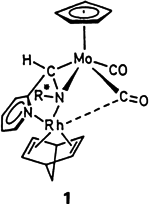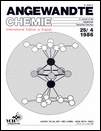[Cp(CO)2Mo{NR*[Rh(norbornadiene)]-CH(pyridyl)}], a Rhodium Complex with an Asymmetric Molybdenum Atom in the Chelate Skeleton†
Optically Active Transition Metal Complexes, Part 90. This work was supported by the Deutsche Forschungsgemeinschaft, the Fonds der Chemischen Industrie, and BASF AG. Part 89: I. Bernal, G. M. Reisner, H. Brunner, G. Riepl, Inorg. Chim. Acta 103 (1985) 179.
Graphical Abstract
Four centers of chirality—2 × C, 1 × N, 1 × Mo—are present in the title compound 1, R* = (R)-1-CHMePh. Complex 1 is characterized, among other things, by a slightly bent CO group, which is in close contact to Rh. A complicated series of ring openings and epimerizations is suggested as a plausible route to 1.





